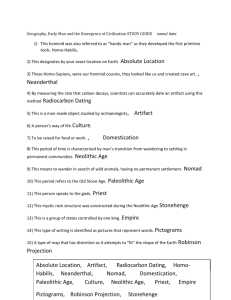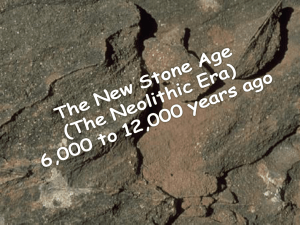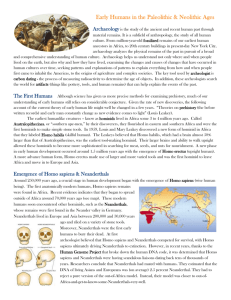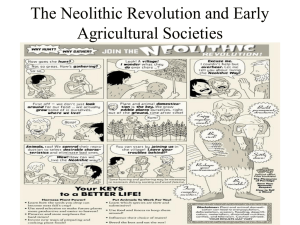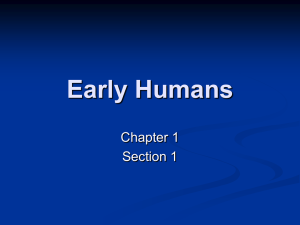Paleolithic and Neolithic Era
advertisement
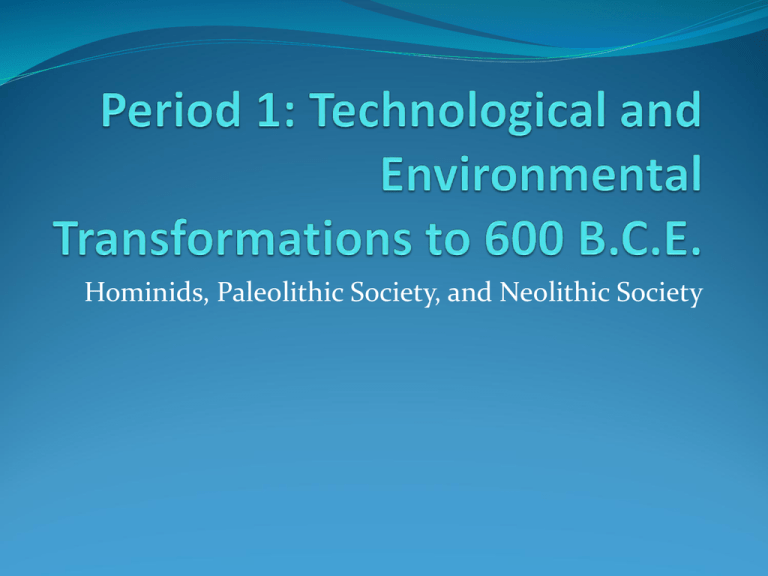
Hominids, Paleolithic Society, and Neolithic Society Key Concepts 1.1 – Big Geography and the Peopling of the Earth 1.2 – The Neolithic Revolution and Early Agricultural Societies 1.3 – The Development and Interactions of Early Agricultural, Pastoral, and Urban Societies My How We’ve Changed… First Humans: Lucy 3 ft 5 in 55 lbs 3.5 Million Years Old Ethiopia Oldest Skeleton ever found. Key Difference b/t Humans and Animals in History Animals – Adapt to environment to meet the demands of the environment Humans – Adapt the environment to meet the demands of humans The Hominids Hominids – Include human and human like species. Australopithecus – Short, hairy, upright, limited in intelligence, opposable thumbs. Lived in eastern and southern Africa Phased out by about one million years ago. Many remains found in Africa The Hominids Homo Erectus – “Upright- walking human.” Flourished from 2.5 million – 200,000 years ago. Larger brain, more intelligent. Fire Tools: Axes, cleavers Language Migrated – North Africa, Eurasian landmass Homo Sapiens Homo Sapiens – “Consciously thinking human” 200,000 years ago Possessed higher levels of intelligence and communication allowing them to adapt (i.e. – created clothing for cold weather, complex weapons) Intelligence allowed movement – Africa, Europe, Asia, Indonesia, New Guinea, Australia, Siberia, Alaska, North America Paleolithic Society Paleolithic Era – The Old Stone Age Start: First Hominids End: Twelve Thousand Years Ago Key Characteristic – Human beings foraged for their food. Hunted wild animals or gather edible products from naturally growing plants Paleolithic Society Relative Social Equality Hunter Gatherers Meant they followed prey and moved with seasons Lived in small groups Resulted in no private ownership and relative equality Areas where food was especially rich sometimes meant abandonment of hunter gatherer lifestyle in exchange for permanent settlements. i.e.- Chinooks of the Pacific Northwest Paleolithic Culture Paleolithic Culture – Evidence of reflection Complex Burials (Neandertal people) Creative Achievements Cro-Magnon People Very similar to modern humans – Intelligence, Communication, Appearance Harpoons, Bows and Arrows Jewelry Furniture Venus Figurines (p. 17) Cave Paintings (p. 18) The Neolithic Era The Neolithic Era – “The New Stone Age.” Refers to the early stages of agricultural society. Involved the systematic cultivation of crops and domestication of animals. Meant phasing out of the hunter-gatherer lifestyle 12,000-6,000 years ago Slow and gradual process Neolithic Era Early Agricultural Society Increased food supply lead to huge population increase (p. 24) Villages and towns sprung up (Jericho and Catal Huyuk) Lead to specialization of labor Metalworking, pottery, and textile production The Neolithic Era Social Distinctions First time people had opportunity to accumulate wealth Due to specialization of labor and increased value of land Class System developed as a result (first time for rich and poor) The Neolithic Era Neolithic Culture Accumulated working knowledge of the earth’s rhythms and passed them on Religious beliefs in multiple gods associated with multiple things: Death, fertility, etc. The Neolithic Era Emergence of cities Dense populations, specialized labor, and complex social relationships created by agriculture eventually gave rise to cities. Larger and more complex than villages Specialization – Tax Collectors, military strategists, governors, etc. Influenced the political, cultural, and economic life of larger regions around the world.


